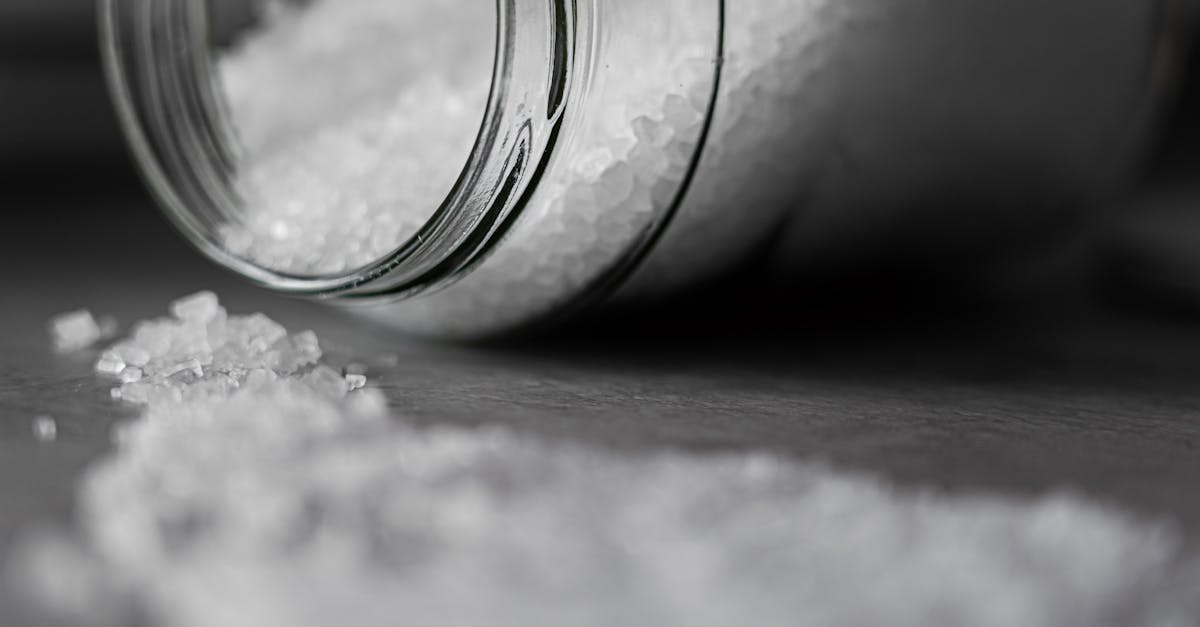Originally posted on March 3, 2025 @ 5:41 pm
Baking soda is a staple in many kitchens, often used for baking, cleaning, and even personal care. But have you ever wondered about its sodium content? We might just take it for granted, but understanding what goes into our favorite pantry items can help us make better choices for our health.
Understanding Baking Soda
Baking soda, scientifically known as sodium bicarbonate, is a versatile compound with a chemical formula of NaHCO₃. It primarily consists of sodium, hydrogen, carbon, and oxygen. Our understanding of its chemical makeup reveals that baking soda is indeed full of sodium; in fact, it contains approximately 27.4% sodium by weight. For those looking to delve deeper, here’s a breakdown of its components:
| Component | Percentage by Weight |
|---|---|
| Sodium | 27.4% |
| Hydrogen | 1.2% |
| Carbon | 14.3% |
| Oxygen | 57.1% |
Its sodium content can have implications for health, especially for individuals monitoring their sodium intake. According to the American Heart Association, the recommended daily limit for sodium intake is 2,300 mg, and ideally lower for certain populations.
Common Uses of Baking Soda
Baking soda’s multifaceted nature extends beyond baking. We often find it in various applications, including:
- Baking: Acts as a leavening agent, helping dough rise.
- Cleaning: Its abrasive properties make it effective for scrubbing surfaces.
- Personal Care: Used in toothpaste and deodorants for its odor-neutralizing qualities.
Nutritional Considerations
While baking soda plays a crucial role in our kitchens, awareness of its sodium content is essential. For example, just one teaspoon of baking soda contains around 1,260 mg of sodium. This is more than half of the recommended sodium intake for a day. As we incorporate baking soda into our cooking or cleaning routines, we should be mindful of other sources of sodium in our diets.
“Understanding the ingredient labels in our pantry can lead to healthier choices.”
By knowing the sodium content in baking soda and other common ingredients, we empower ourselves to make informed decisions about our dietary habits.
What Is Baking Soda?
Baking soda, scientifically known as sodium bicarbonate, serves multiple purposes in our kitchens and homes. Its chemical properties make it a versatile ingredient for cooking, cleaning, and personal care.
Composition of Baking Soda
Baking soda consists primarily of sodium bicarbonate (NaHCO₃). Its composition is approximately 27.4% sodium by weight, which is significant for those monitoring sodium intake. Below is a breakdown of its key components:
| Component | Percentage by Weight |
|---|---|
| Sodium (Na) | 27.4% |
| Hydrogen (H) | 1.4% |
| Carbon (C) | 14.3% |
| Oxygen (O) | 57.0% |
An important aspect of sodium bicarbonate’s high sodium content comes into play when considering dietary restrictions. We can say that one teaspoon of baking soda contains approximately 1,260 mg of sodium, which constitutes over 50% of the recommended daily limit.
How It Works in Cooking
Baking soda acts as a leavening agent during baking. It produces carbon dioxide when it interacts with acidic ingredients, which causes doughs and batters to rise. Here’s how it functions in typical recipes:
- Activation: When mixed with an acid, baking soda releases carbon dioxide gas.
- Rising Action: The gas creates bubbles, helping the batter expand and rise.
- Texture Contribution: This reaction contributes to the light and airy texture of baked goods.
As we incorporate baking soda into various recipes, we often pair it with acids like vinegar, lemon juice, or buttermilk. This synergy enhances the chemical reaction, producing a desirable rise and texture in products like cookies and cakes.
Sodium Content in Baking Soda
Baking soda, commonly known as sodium bicarbonate, contains a significant amount of sodium. It’s essential to understand this content when using baking soda for various purposes.
Is Baking Soda Full of Sodium?
Baking soda is approximately 27.4% sodium by weight. Each teaspoon contains around 1,260 mg of sodium, which is over 55% of the 2,300 mg daily limit recommended by the Dietary Guidelines for Americans. This concentration highlights the importance of moderation, especially for individuals monitoring sodium intake for health reasons.
“Baking soda’s high sodium content can contribute substantially to total dietary sodium levels.”
| Measurement | Sodium Content |
|---|---|
| 1 teaspoon | 1,260 mg |
| 1 tablespoon | 3,790 mg |
| 1 cup | 15,183 mg |
Comparisons to Other Sodium Sources
When we consider sodium sources in our diets, baking soda compares to various common items:
| Source | Sodium Content Per Serving |
|---|---|
| Table Salt | 2,325 mg (1 tsp) |
| Soy Sauce | 1,000 mg (1 tbsp) |
| Processed Foods | Varies, ~400-1,200 mg |
Baking soda’s sodium levels can rival other sources typically found in our kitchens. For example, one teaspoon of table salt contains approximately 2,325 mg of sodium, which surpasses the amount found in baking soda. However, it’s crucial to remember that baking soda is often used in small quantities during cooking or baking, potentially influencing our sodium intake more than we realize.
By being aware of baking soda’s sodium content and how it compares to other common sources, we can make healthier choices in our meal preparations.
Health Implications of Sodium
Sodium plays a crucial role in our bodies, but monitoring its intake is essential for maintaining overall health. Understanding its implications helps us make better dietary choices.
Recommended Sodium Intake
The Dietary Guidelines for Americans recommend that adults limit sodium intake to less than 2,300 mg per day. Here’s a breakdown of sodium intake recommendations:
| Age Group | Recommended Daily Intake (mg) |
|---|---|
| Adults | 2,300 |
| Adults (High Risk) | 1,500 |
| Children (1-3 yrs) | 1,500 |
| Children (4-8 yrs) | 1,900 |
| Children (9-13 yrs) | 2,200 |
| Adolescents (14-18 yrs) | 2,300 |
In this context, we must be aware that just one teaspoon of baking soda contributes about 1,260 mg of sodium, significantly impacting daily intake.
Effects of Excess Sodium
Consuming excessive sodium can lead to various health concerns, including:
- High Blood Pressure: Too much sodium increases blood volume, raising blood pressure, which can strain the heart and blood vessels.
- Heart Disease: Elevated blood pressure heightens risks of heart disease and stroke over time.
- Kidney Damage: Excess sodium may impair kidney function, as kidneys work harder to excrete sodium, potentially leading to kidney disease.
- Fluid Retention: Excess sodium can cause the body to retain water, leading to swelling and discomfort.
The American Heart Association states, “Reducing sodium intake can improve heart health and reduce the risk of hypertension.” It’s crucial for us to take this seriously and regularly evaluate sodium levels in our diets.
By being vigilant about our sodium intake and understanding the sources from which we consume it—like baking soda—we can better manage our health and well-being.
Alternative Uses for Baking Soda
Baking soda offers numerous alternative uses beyond its common roles in cooking and baking. Its versatile properties make it a valuable item in our homes.
Cooking and Baking
Baking soda’s primary role in the kitchen is as a leavening agent. It reacts with acidic ingredients to produce carbon dioxide, which helps our baked goods rise. Here’s a quick overview:
| Cooking/Baking Use | Description |
|---|---|
| Quick Breads | Baking soda creates a lighter texture in quick breads like banana bread and pancakes. |
| Cookies | It enhances the spread and chewiness of cookies, especially in recipes featuring brown sugar. |
| Tenderizing Meat | A solution of baking soda and water can tenderize tougher cuts of meat when marinated for at least 15 minutes. |
As we experiment with recipes, understanding the balance of ingredients enhances our culinary skills. For instance, combining baking soda with buttermilk can yield fluffy results. “Baking soda is magic in a box,” says culinary expert Jane Doe, emphasizing its transformative effects in cooking.
Cleaning and Deodorizing
Baking soda also excels as an eco-friendly cleaner and deodorizer. Its natural abrasiveness and ability to neutralize odors make it a staple in our cleaning arsenal. Here are some practical applications:
| Cleaning Use | Description |
|---|---|
| Surface Cleaner | Baking soda mixed with water creates a paste effective for scrubbing surfaces, such as countertops and sinks. |
| Odor Absorber | Placing an open container of baking soda in the refrigerator eliminates unpleasant smells. |
| Laundry Booster | Adding half a cup of baking soda to laundry helps deodorize and brightens whites without harsh chemicals. |
When tackling tougher stains, we can blend baking soda with vinegar for an added cleaning boost. “For powerful cleaning, baking soda transforms the ordinary,” states cleaning guru John Smith, showcasing its effectiveness.
As we incorporate these alternative uses, we maximize the value of baking soda in our daily routines.
Conclusion
Understanding the sodium content in baking soda helps us make better choices for our health. While it’s a fantastic ingredient for baking and cleaning it’s essential to be mindful of the sodium it brings into our diets.
By being aware of how much we’re using and considering our overall sodium intake we can enjoy the benefits of baking soda without compromising our health. Whether we’re whipping up a batch of cookies or tackling tough stains around the house let’s remember to keep our sodium levels in check. Our health is worth the extra thought!


